Stem Cells
- A stem cell is a cell that can divide (by mitosis) an unlimited number of times
- Each new cell (produced when a stem cell divides) has the potential to remain a stem cell or to develop into a specialised cell such as a blood cell or a muscle cell (by a process known as differentiation)
- This ability of stem cells to differentiate into more specialised cell types is known as potency
- There are four types of potency:
- Totipotency – totipotent stem cells are stem cells that can differentiate into any cell type found in an embryo, as well as extra-embryonic cells (the cells that make up the placenta). The zygote formed when a sperm cell fertilises an egg cell is totipotent, as are the embryonic cells up to the 16-cell stage of human embryo development
- Pluripotency – pluripotent stem cells are embryonic stem cells that can differentiate into any cell type found in an embryo but are not able to differentiate into extra-embryonic cells (the cells that make up the placenta)
- Multipotency – multipotent stem cells are adult stem cells that can differentiate into closely related cell types (e.g. bone marrow stem cells differentiate into different blood cells)
- Unipotency - unipotent stem cells are adult cells that can only differentiate into their own lineage, e.g. heart muscle cells (cardiomyocytes) can generate new cardiomyocytes through the cell cycle to build and replace heart muscle. Most cells in animal bodies are unipotent
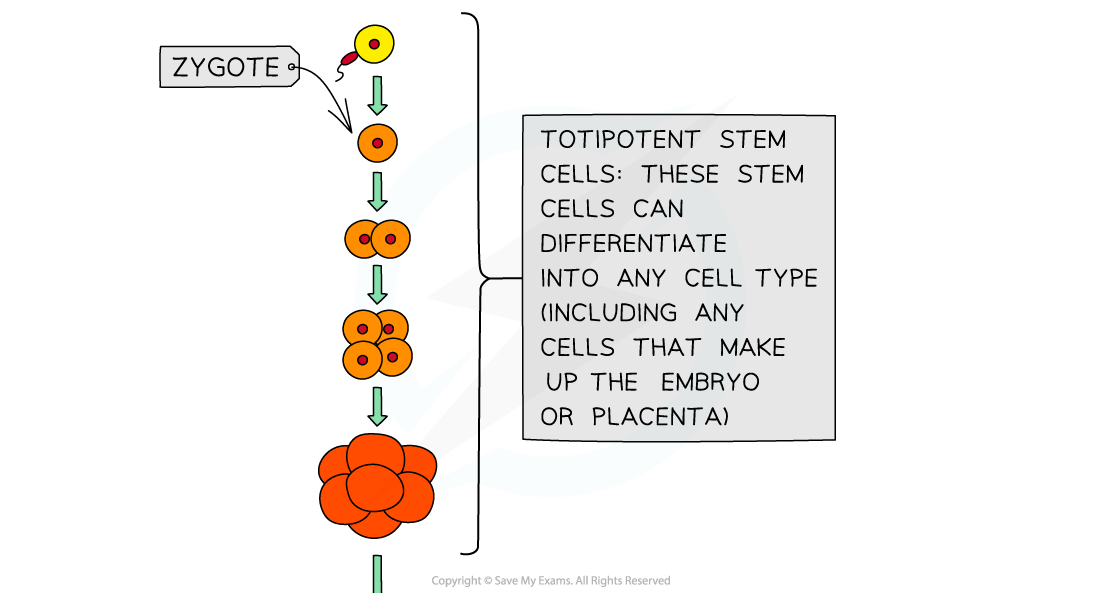
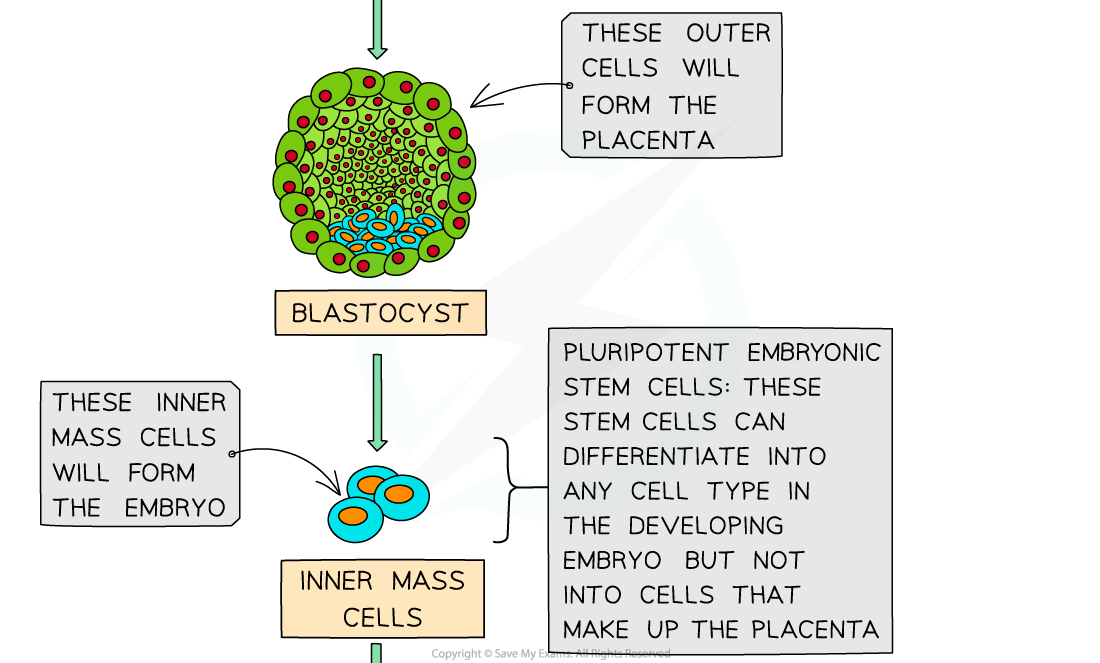
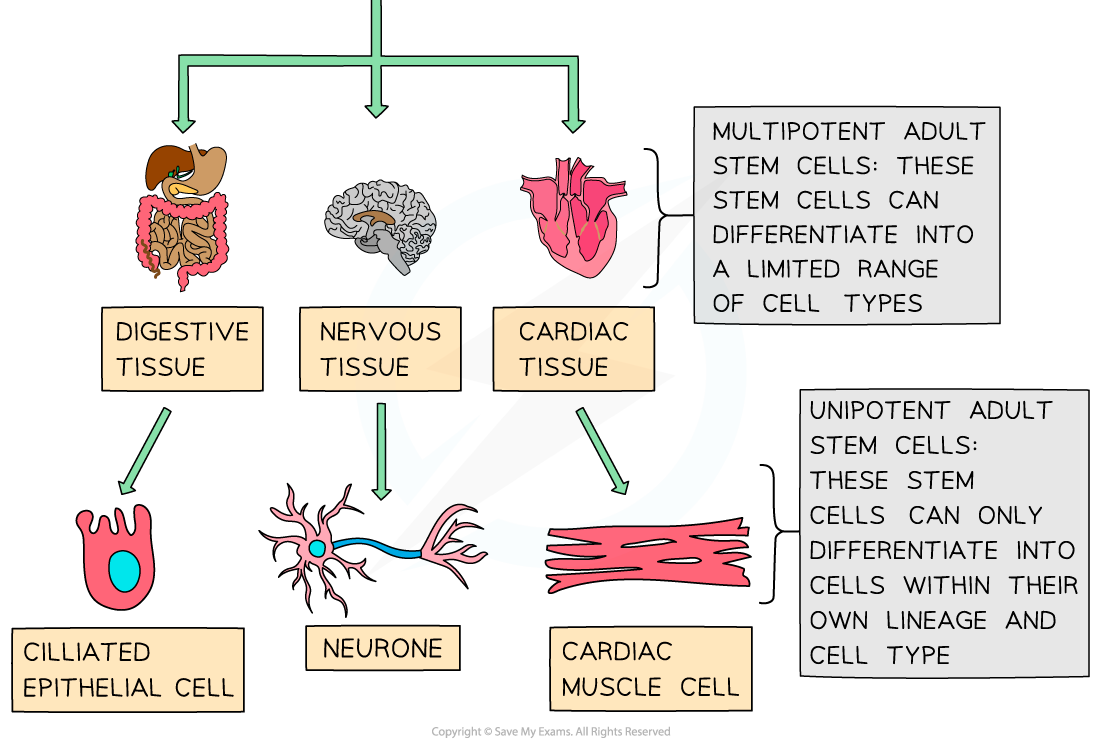
There are different levels of potency that cells can have. Totipotent cells have the highest potency and can therefore differentiate into any type of cell. Unipotent cells have the lowest potency, only being able to divide into one cell type.
Exam Tip
Remember the two key properties of stem cells are that they can self-renew (capacity to divide) and can differentiate.Make sure you learn the three levels of potency of stem cells described above, and what range of cell types these stem cells can differentiate into.Don’t forget, while still classed as stem cells (as they can divide any number of times), only a limited range of specialised cells can be formed from adult stem cells as they have already partially differentiated. For example, stem cells in bone marrow can only produce cells that differentiate into the different types of blood cells.
Stem Cells: Therapeutic Use
- Currently, there are very few therapeutic uses of stem cells, although scientists around the world are actively involved in researching potential therapies
- The research is being carried out on embryonic (totipotent and pluripotent) and adult (multipotent) stems cells
Use of embryonic stem cells
- Due to their ability to differentiate into multiple cell types, stem cells have huge potential in the therapeutic treatment of disease
- For many countries, such as the USA and some countries within the EU, the use of embryonic stem cells is banned, even for research
- In other countries, such as the UK, the use of embryonic stem cells is allowed for research but is very tightly regulated
- Embryonic stem cells can be one of two potencies:
- Totipotent if taken in the first 3-4 days after fertilisation
- Pluripotent if taken on day 5
- The embryos used for research are often the waste (fertilised) embryos from in vitro fertilisation treatment
- This means these embryos have the potential to develop into human beings
- This is why many people have ethical objections to using them in research or medicine
Stargardt's disease
- Stargardt's disease is the most common inherited form of juvenile macular degeneration and mainly affects children and adolescents
- The macula is located in the central region of the retina and damage to this area limits our central vision and colour perception
- The disease is commonly caused by a mutation of the ABCA4 gene resulting in a protein in the retina malfunctioning, eventually leaving the person legally blind
- One treatment that was researched was the injection of retina cells derived from embryonic stem cells into patients eyes. This treatment had success and no harmful side effects were experienced, however trials are still ongoing
Use of multipotent adult stem cells
- As tissues, organs and organ systems develop, cells become more and more specialised
- Having differentiated and specialised to fulfil particular roles, most adult cells gradually lose the ability to divide until, eventually, they are no longer able to divide
- However, small numbers of stem cells (known as adult stem cells) remain to produce new cells for the essential processes of growth, cell replacement and tissue repair
- Although these adult stem cells can divide (by mitosis) an unlimited number of times, they are only able to produce a limited range of cell types – they are multipotent
- For example, the stem cells found in bone marrow (hematopoietic stem cells) are multipotent adult stem cells – they can only differentiate into blood cells (red blood cells, monocytes, neutrophils and lymphocytes)
- In adults, multipotent stem cells can be found throughout the body (eg. in the bone marrow, skin, gut, heart and brain)
- Research is being carried out on stem cell therapy, which is the introduction of adult stem cells into damaged tissue to treat diseases (eg. leukemia) and injuries (eg. skin burns)
Leukaemia
- Leukaemia is the generalised term referring to a group of cancers that develop in the bone marrow
- It is caused by mutations in genes resulting in the over-production of abnormal white blood cells (leukocytes)
- To destroy these mutated cells in the bone marrow patients undergo chemotherapy
- However, as the chemicals injected into the patient's body during chemotherapy destroy all bone marrow cells, hematopoietic stem cells (HSCs), the adult stem cells found in bone marrow, are removed using a large needle before treatment
- These HSCs are stored frozen and after chemotherapy, they are returned via a transfusion. Once in the body, the HSCs re-establish themselves in the bone marrow where they begin producing blood cells
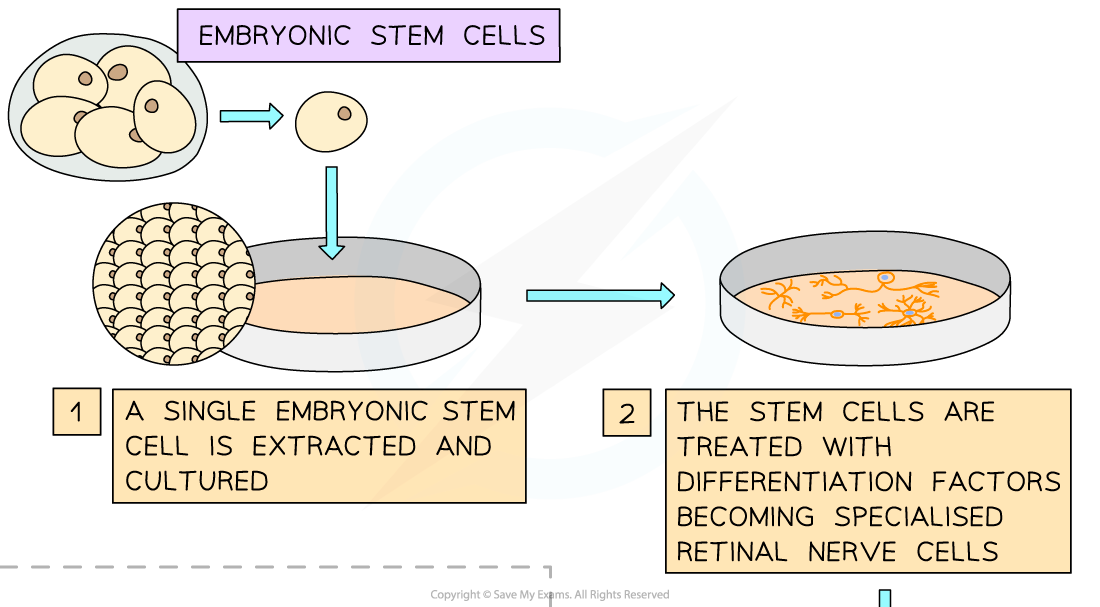
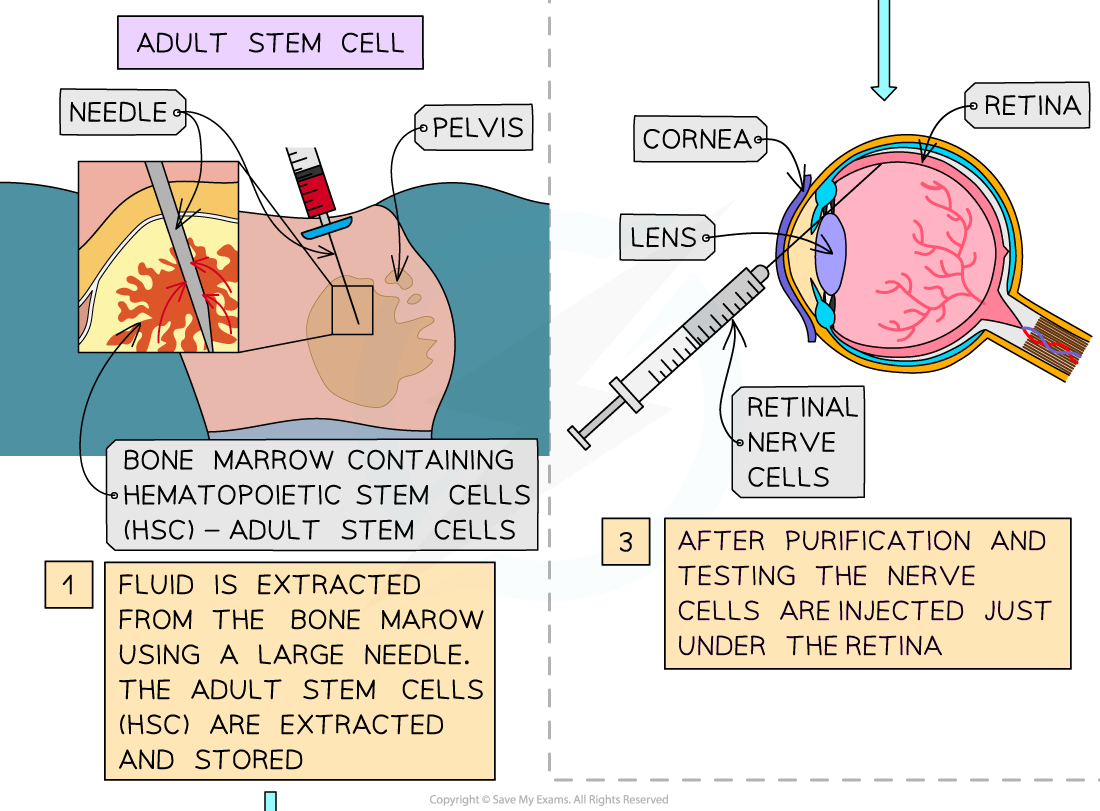
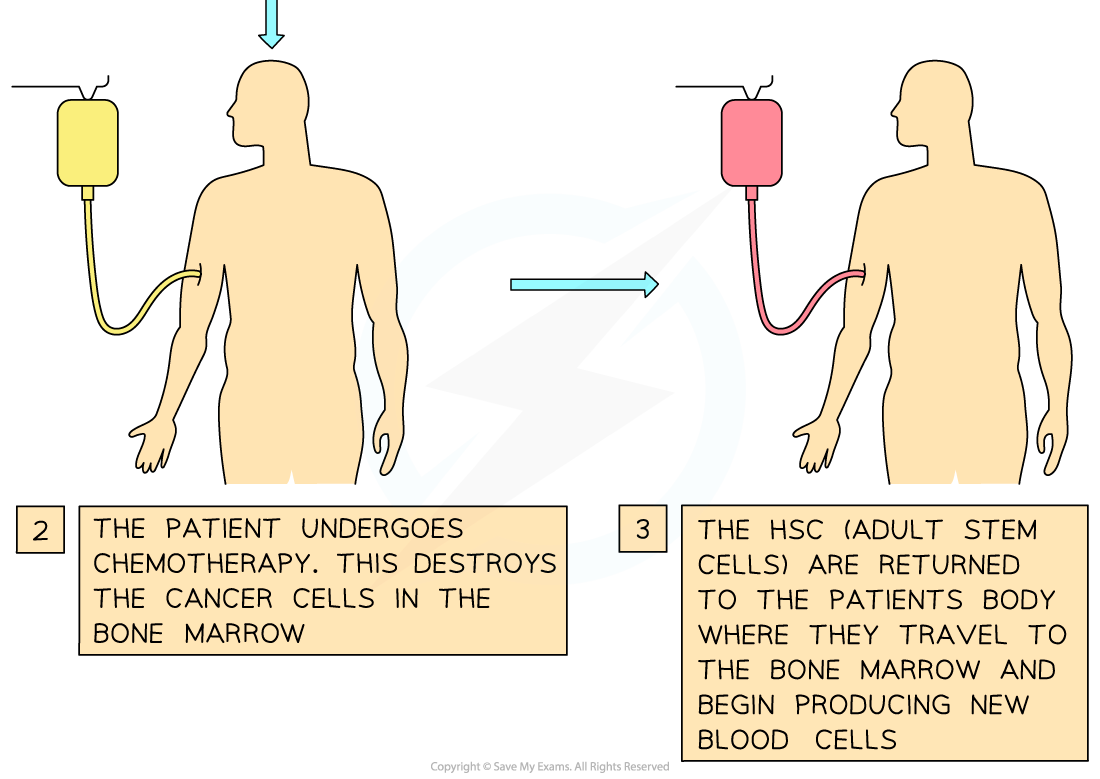
Therapeutic uses of embryonic and adult stem cells
Stem Cells: Ethics
NOS: Ethical implications of research; research involving stem cells is growing in importance and raises ethical issues
- Ethics are the rules provided by external sources that allow us to determine whether something is right or wrong
- Before scientists undertake research it is important for them to consider the ethics and consequences
- Research involving stem cells may:
- Lead scientists to make discoveries and create beneficial technologies that would not have occurred if the research had been banned
- Cure diseases or disabilities
- Enable organs to be regenerated or repaired, thus reducing the demand for organ transplants
Sources of Stem Cells
- One of the ethical considerations researchers need to take is to determine what the source of the stem cells is to be. There are three possible sources:
- Embryos, which can be created using therapeutic cloning
- Cord blood (umbilical) of new-born babies, which can be frozen and stored
- Specific adult tissues, e.g. bone marrow
Ethics of Using Stem Cells
Arguments for:
- Embryonic stem cells:
- These cells are totipotent or pluripotent therefore they can differentiate into any cell type and thus give the patient a higher chance of living a healthy life
- Embryonic stem cells are not differentiated. Therefore there is less chance of genetic damage, due to an accumulation of mutations, which improves the likelihood of a healthy life for the patient
- Any of these cells produced by IVF that have been set aside to be discarded could instead be used for research into incurable diseases
- Cord blood stem cells:
- Can be easily obtained and stored and therefore are readily available when required
- Are fully compatible with the tissues of the adult, as they are genetically identical, and therefore reduce the risk of rejection if used
- Would be lost when the umbilical cord is discarded
- Adult stem cells:
- It is less controversial to use adult stem cells compared to embryonic stem cells because the donor is able to give permission, e.g., many people donate bone marrow to help treat leukaemia patients
- There is a lower chance of rejection as the patient's own adult stem cells are being used to treat them
- A lower chance of developing into tumours
- Can be removed without any long-lasting side effects to the patient
Arguments against:
- Embryonic stem cells:
- These cells have a higher risk of developing into tumours
- The process involves the creation and destruction of embryos (but at which point are embryos considered alive)
- Cord blood stem cells:
- The cells are multipotent and therefore have a limited capacity to differentiate into different cell types
- Adult stem cells:
- Adult stem cells are difficult to obtain as there are a small number of them and so they can be painful to extract as they are buried deep in tissue
- Are multipotent and therefore have a limited capacity to differentiate into different cell types
- If adult stem cells are being donated from one person to another they need to be a close match in terms of blood type and other body antigens or there is a chance that the cells used will be rejected by the patient's immune system
Stem Cell Ethics Table
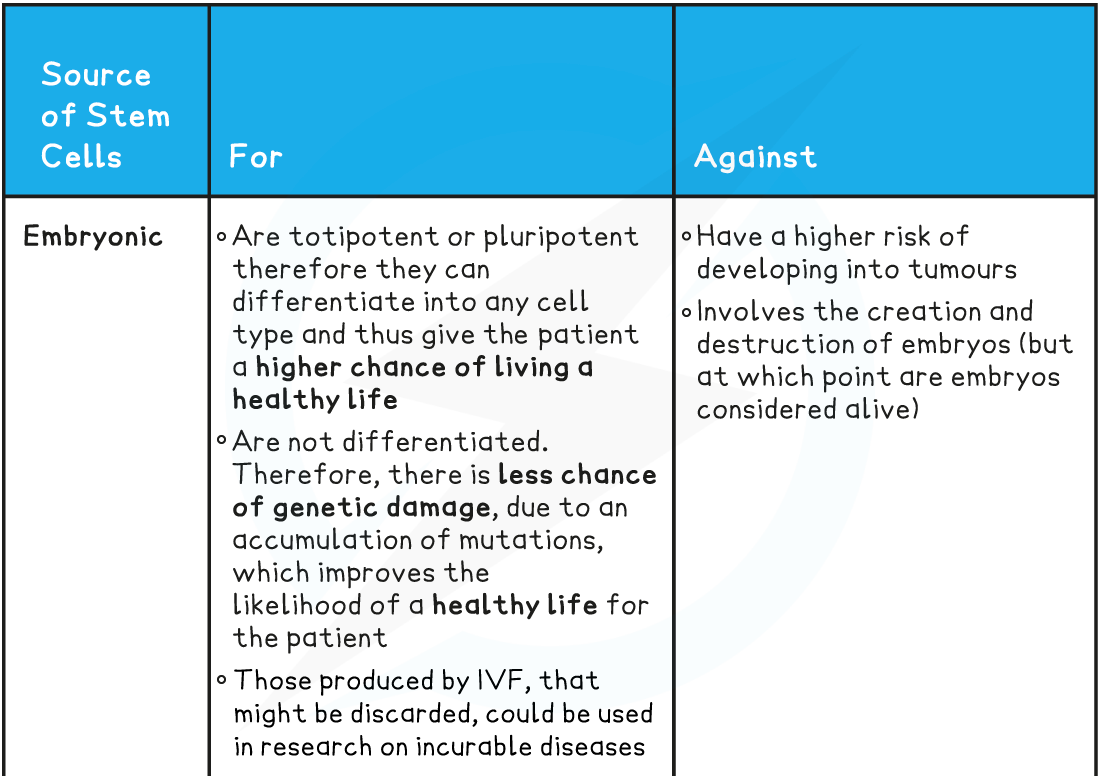
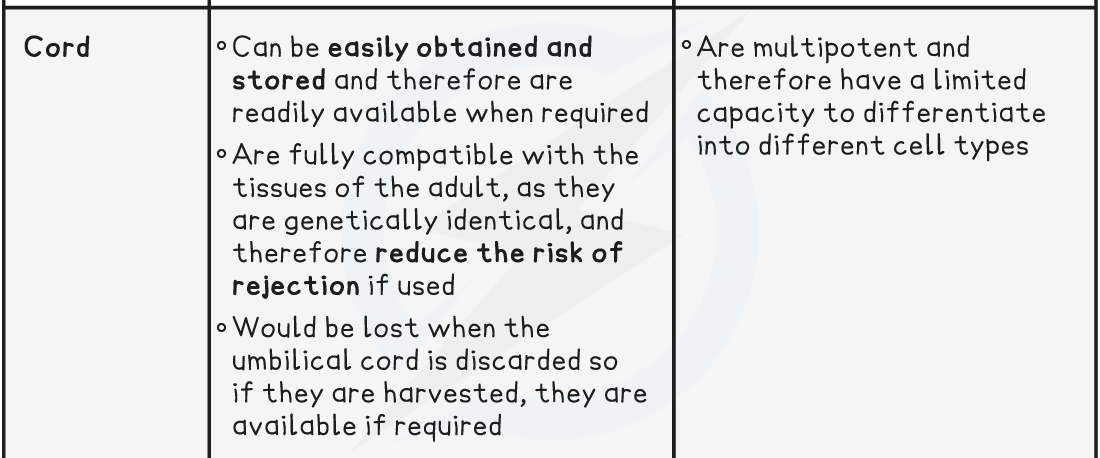

Exam Tip
It is important to learn arguments for and against using the three sources of stem cells for therapeutic uses.